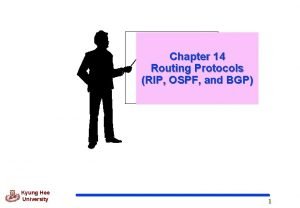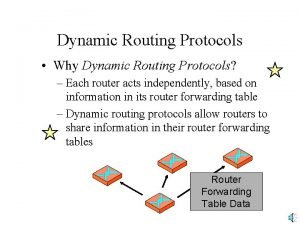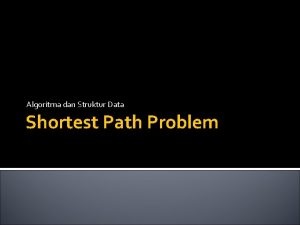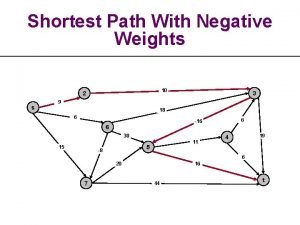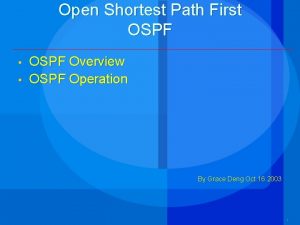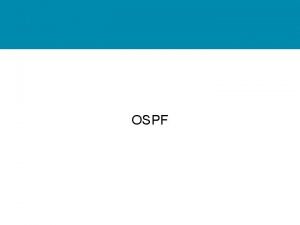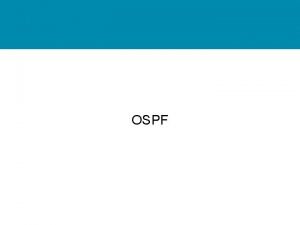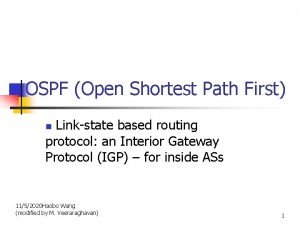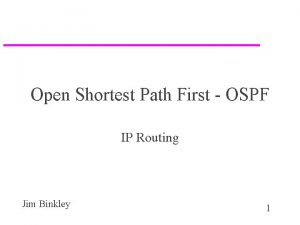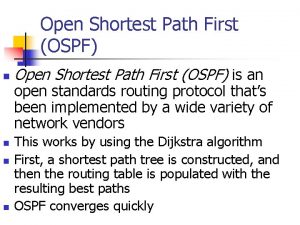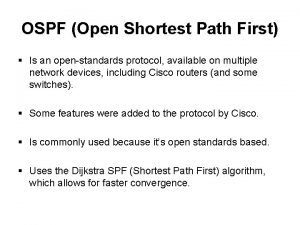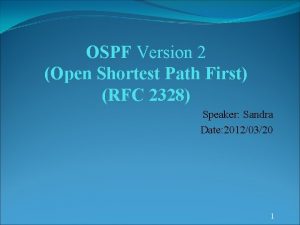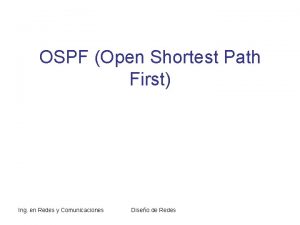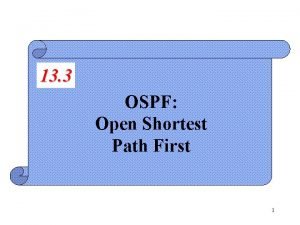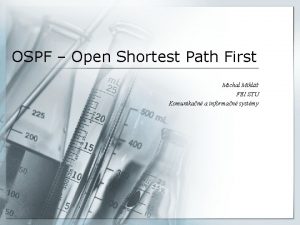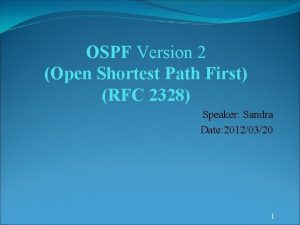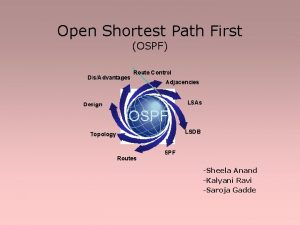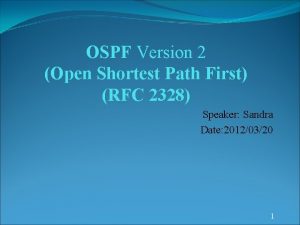Minimax Open Shortest Path First OSPF Routing Algorithms




















- Slides: 20

Minimax Open Shortest Path First (OSPF) Routing Algorithms in Networks Supporting the SMDS Service Frank Yeong-Sung Lin (林永松) Information Management Department National Taiwan University Taipei, Taiwan, R. O. C.

Outline • Introduction to SMDS • The default Inter-Switching System Interface (ISSI) routing algorithm • Minimax Criteria • Problem Formulation • Solution Procedures • Computational Results • Summary 2

Introduction to the SMDS Service • Switched Multi-megabit Data Service (SMDS) is a public, high-speed, connectionless (datagram), packet switched data service that the Regional Bell Operating companies (RBOCs) have offered. • Provides LAN-like performance and features over a wide area. • Regarded as the first phase of B-ISDN • High-speed access (1. 5 Mbps to 45 Mbps) • Multicast capability 3

The Default ISSI Routing Algorithm • Open Shortest Path First (OSPF) routing algorithms – Each Switching System (SS) has identical information about (i) the network topology and (ii) the link set metrics. – Each SS uses the link set metrics (arc weights) to calculate a shortest path spanning tree (by applying the Dijkstra’s algorithm) for each root to transmit individually addressed and group addressed (multicast) traffic. – OSPF routing protocols are also widely applied in the Internet and other high-speed networks. 4

The Default ISSI Routing Algorithm • The default link set metrics: inversely proportional to the link set capacities • Advantages – Simplicity (static) – Minimizing the total link set utilization factors • Disadvantages – Does not respond to the network load fluctuation – Does not impose link set capacity constraints 5

Minimax Criteria • The maximum link set utilization is minimized. • Advantages: – – – Respond to and balance the network load Remain optimal if network load grows uniformly Robust to demand fluctuation The difficulty of non-linearity is circumvented Perform well with respect to other performance measures, e. g. packet loss rate and average packet delay – Conform to the default routing algorithm (OSPF) 6

Problem Formulation • • • Notation The network is modeled as a graph G(V, L). V = {1, 2, …, N}: the set of nodes in the graph. L: the set of links in the graph (network). W: the set of O-D pairs (with individually addressed traffic demand) in the network. w: the mean arrival rate of new traffic for each OD pair w W. r: the mean arrival rate of multicast traffic for each multicast root r V. 7

Problem Formulation (cont’d) • • • Notation (cont’d) Pw: the set of all possible elementary directed paths form the origin to the destination for O-D pair w. P: the set of all elementary directed paths in the network, that is, P = w W Pw. Ow: the origin of O-D pair w. Tr : the set of all possible spanning trees rooted at r for multicast root r. T : the set of all spanning trees in the network, that is, T = r V Tr. 8

Problem Formulation (cont’d) • • Notation (cont’d) Cl : the capacity of link l L. al: the link set metric for link l L (a decision variable). xp: the routing decision variable which is 1 if path p is used to transmit the packets for O-D pair w and 0 otherwise. pl: the indicator function which is 1 if link l is on path p and 0 otherwise. 9

Problem Formulation (cont’d) Notation (cont’d) • yt: the routing decision variable which is 1 if tree t Tr is used to transmit the multicast traffic originated at root r and 0 otherwise. • tl: the indicator function which is 1 if link l is on tree t and 0 otherwise. 10

Problem Formulation (cont’d) (IP’) subject to: (1) (2) (3) (4) (5) (6) (7) (8) 11

Problem Formulation (cont’d) Define the following notation An equivalent formulation of IP’: ZIP = min s subject to: (9) (10) (11) (12) (13) (14) (15) (16) (17) 12

Solution Approach • A dual approach based on Lagrangean relaxation subject to: 13

Solution Approach (cont’d) A dual approach (cont’d) • (LR) and be decomposed into three independent sub-problems. – A trivial problem for S – A shortest path problem for each O-D pair w – A minimum cost spanning tree problem for each root r • The dual problem is. • The subgradient method is applied to solve the dual problem. • A heuristic for determining the link set metrics is to let al be ul. 14

Solution Approach (cont’d) A primal approach (1) Assign an initial value to each al. Set the iteration counter k to be 1. (2) If k is greater than a pre-specified counter limit, stop. (3) Apply Dijkstra’s shortest path algorithm to calculate a shortest path spanning tree for each origin. (4) Calculate the aggregate flow for each link. (5) Identify the set of link(s) with the highest utilization, denoted by S. (6) For each l S, increase al by a positive value tk. (7) Increase k by 1 and go to Step 2. 15

Solution Approach (cont’d) • The following two properties of {tk} are suggested – approaches infinity and – tk approaches 0 as k approaches infinity. • Advantages of the primal approach – The algorithm is simple. – Both types of traffic are considered in a uniform way. 16

Computational Results • The dual approach provides lower bounds on ZIP so that the quality of the heuristic solutions can be evaluated. • The dual approach is expected to perform well when |L| / |W| is small. • Compared with the default ISSI routing, the minimax routing algorithm based upon the dual approach results in a 7% to 53% improvement in the maximum link utilization. 17

Computational Results (cont’d) 21 -node 52 -link ARPA 2 network 15 -node 38 -link SWIFT network 14 -node 42 -link PSS network 12 -node 50 -link GTE network 18

Computational Results (cont’d) • The primal approach is in general (but not uniformly) superior to the dual approach in terms of computation time and quality of solutions. • It is then suggested that the dual and the primal approaches be applied in a joint fashion to achieve better performance. • Compared with the default ISSI routing, the joint (combining the primal and the dual approach) minimax routing algorithm results in a 13% to 133% improvement in the maximum link utilization. 19

Summary • Investigate more responsive routing algorithms than the ISSI routing scheme (OSPF routing with default link set metrics) for SMDS networks. • Find a new set of link set metrics such that the maximum link set utilization is minimized. • Formulate the problem as a nonlinear mixed integer programming problem. • Propose two solution procedures. • Compared with the default ISSI routing, the proposed minimax routing algorithm results in a 13% to 133% improvement in the maximum link utilization. 20
 Spf algorithm
Spf algorithm Stub link
Stub link Ospf routing protocol
Ospf routing protocol Ospf routing protocol
Ospf routing protocol Badrinath
Badrinath Delivery routing algorithms
Delivery routing algorithms Level pool routing
Level pool routing Mark tinka
Mark tinka Hydrologic routing and hydraulic routing
Hydrologic routing and hydraulic routing Routing in physical design
Routing in physical design Shortest path to get food
Shortest path to get food Difference constraints and shortest paths
Difference constraints and shortest paths Dijkstra's shortest path algorithm
Dijkstra's shortest path algorithm Floyd's algorithm pseudocode
Floyd's algorithm pseudocode Shortest path problem in discrete mathematics
Shortest path problem in discrete mathematics Shortest path problem adalah
Shortest path problem adalah Shortest path with negative weights
Shortest path with negative weights What is shortest path algorithm in data structure
What is shortest path algorithm in data structure Widest path problem dijkstra
Widest path problem dijkstra Shortest path in weighted graph
Shortest path in weighted graph Shortest path from source to destination in weighted graph
Shortest path from source to destination in weighted graph

